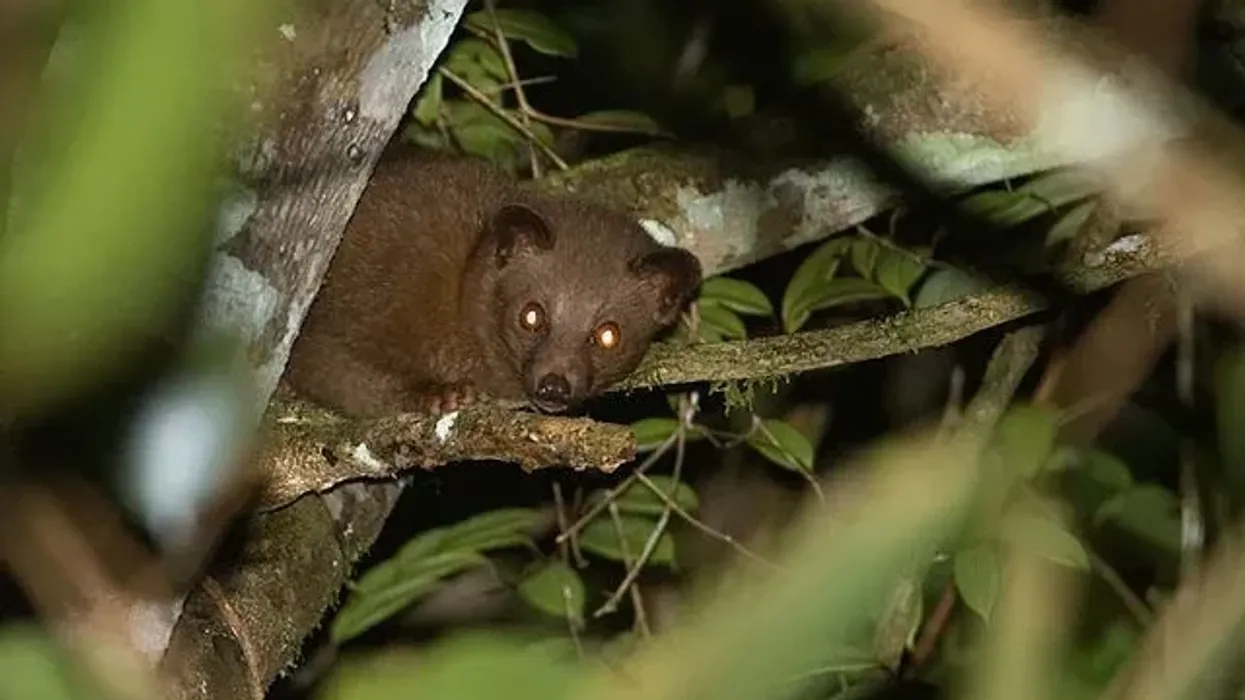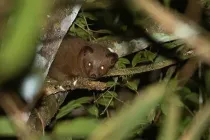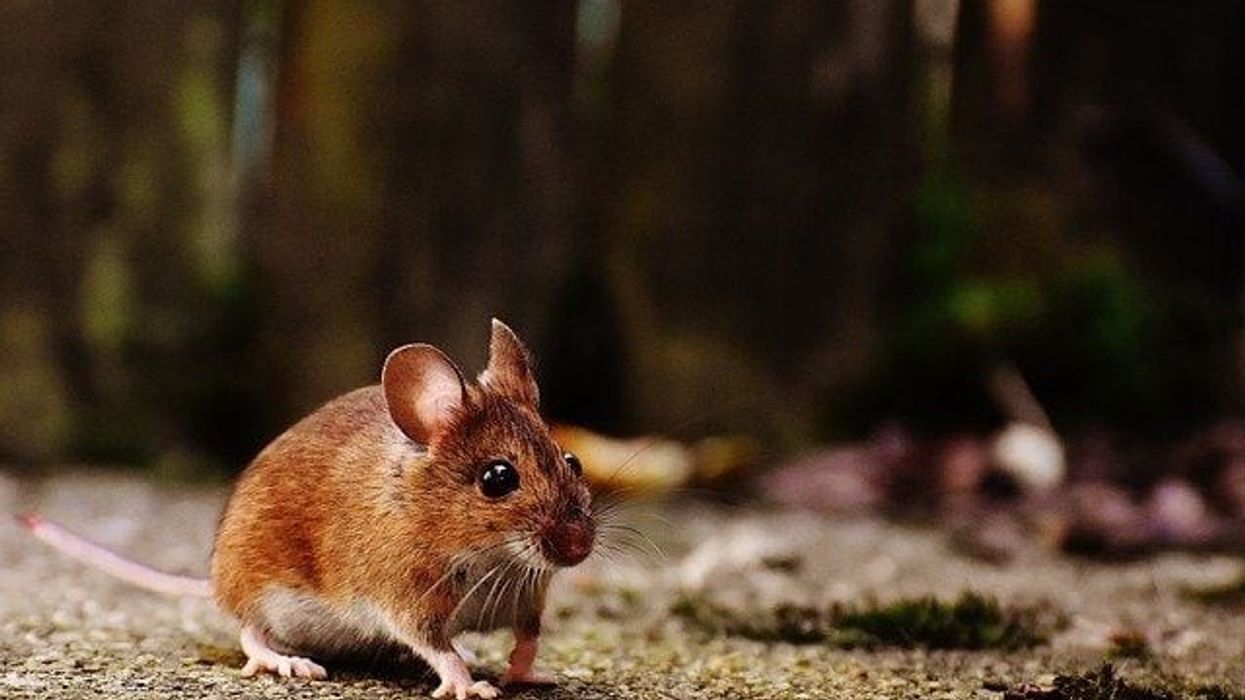Fun Golden Palm Civet Facts For Kids

Content
- What type of animal is a golden palm civet?
- What class of animal does a golden palm civet belong to?
- How many golden palm civets are there in the world?
- Where does a golden palm civet live?
- What is a golden palm civet's habitat?
- Who do golden palm civets live with?
- How long does a golden palm civet live?
- How do they reproduce?
- What is their conservation status?
- What do golden palm civets look like?
- How cute are they?
- How do they communicate?
- How big is a golden palm civet?
- How fast can a golden palm civet run?
- How much does a golden palm civet weigh?
- What are the male and female names of the species?
- What would you call a baby golden palm civet?
- What do they eat?
- Are they dangerous?
- Would they make a good pet?
- Did you know...
- Is a civet an omnivore?
- Is the palm civet poisonous?
The golden palm civet is a small-medium-sized catlike animal that is endemic to the island nation of Sri Lanka.
Golden palm civets, unlike some of the other civet species, are considered to be a vulnerable species as they have seen a massive decline in population over the years due to human interference in their natural habitat range as a result of which they have often been hunted and chased away.
These creatures have short legs with sharp claws which they use to climb trees as they are an arboreal species and spend most of their time on treetops. Their population distribution is fragmented and as of now, there is so estimated population count since these species are hard to come by.
They have been put under conservation efforts in an attempt to bring their population back to their old numbers and illegal poaching or hunting of this species is a punishable offense.
If you liked these true facts about golden palm civets, then you'll surely like Indian civet facts and masked palm civet facts too!
Golden Palm Civet Interesting Facts
What type of animal is a golden palm civet?
The golden palm civet (Paradoxurus zeylonensis) is a solitary arboreal mammal endemic to the country of Sri Lanka and belongs to the Viverridae family of small-medium-sized mammals.
These mammals were known as the Viverra zeylonensis, but after the introduction of more civet specimens like the P. aureus, P. montanus, and P. stenocephalus, they were given the scientific name of P. zeylonensis.
These animals are exclusive to Sri Lanka, unlike other civets, for example, the banded palm civet, which can be found throughout Asia.
What class of animal does a golden palm civet belong to?
The golden palm civet (Paradoxurus zeylonensis) belongs to the Mammalia class of animals as it has all the characteristics such as mammary glands, fur, and three bones in its ears that help it qualify as a mammal.
How many golden palm civets are there in the world?
There is not much data on the population of the Sri Lankan golden palm civets (Paradoxurus zeylonensis) as these species have seen a vast decline in their population over the years in their natural habitat range like the forests and mountains.
The population distribution of these animals is scattered throughout forest ranges. As a direct result of this small population distribution, the golden palm civet has been listed as a Vulnerable Species on the IUCN Red List.
Where does a golden palm civet live?
The golden palm civet (Paradoxurus zeylonensis) is found in tropical dry zone regions of Sri Lanka. These nocturnal species spend most of their time in the lowland rain forest, evergreen forests, and monsoon forest range of Sri Lanka and can be found in the Sinharaja Rain Forest and the Wasgamuwa and Yala National Park regions.
What is a golden palm civet's habitat?
Golden palm civets (Paradoxurus zeylonensis) are known for their adaptability and can be found living in a series of zoological ranges including the wet and dry zone of Sri Lanka.
Despite the presence of vast mangrove patches in and around the island shores, the golden palm civets prefer to use the trees in the forests as a habitat for their solitary way of life.
Who do golden palm civets live with?
The golden palm civets (Paradoxurus zeylonensis) belong to the group of solitary animals as these species prefer to spend most of their life alone in trees and will only interact with the other sex during the breeding season and stay together as long as they are raising their young ones.
How long does a golden palm civet live?
Based on the study of these solitary species their average lifespan is estimated to be around eight to nine years, unlike other species of the Viverrid family, like the Asian palm civet which has a lifespan length of 15-20 years.
How do they reproduce?
Because of this species' status as a Vulnerable species, there is not much information regarding their reproduction behavior. It is, however, known that both the male and the female palm civets reach sexual maturity when they are one to two years of age.
The mating period of the golden palm civets occurs once a year and these usually solitary animals come together during this period. Copulation usually takes place in trees as the male mounts the female.
After copulation, the female goes through a gestation period of 72-85 days as is common among the Viverrid family, and gives birth to a litter of two to three babies that are weaned for 52-175 days before they mature and form a group of their own.
What is their conservation status?
The golden palm civet (Paradoxurus zeylonensis) has, over the years, seen massive population loss due to human interference in their natural habitats.
The felling of trees for agricultural and commercial purposes has had a huge impact on their population loss as it is mostly the young ones that are affected the most. Adult palm civets have been the target of hunting for years due to these species carrying rabies.
As a result of all this, the golden palm civet is currently listed as a Vulnerable species on the IUCN Red List.
Golden Palm Civet Fun Facts
What do golden palm civets look like?
Golden palm civets (Paradoxurus zeylonensis) are usually found in two morphs, one is golden brown and the other is dark brown. This nocturnal species is small-bodied and has a long tail.
The length of their coat is usually between 1.1-1.5 in (2.74-3.8 cm) and unlike other civet species, the golden palm civet falls under the group that lacks any black coloration on their bodies or the tail rings.
How cute are they?
These solitary animals are good to look at and you can even go to the length of calling them cute which they are. They have a cat-like body which adds to the cuteness quotient with the golden palm civet babies being the definition of cute!
How do they communicate?
There is little known about the communication behavior of the golden palm civets, however, speaking in general terms, these animals communicate with each other through strong olfactory perception.
Golden palm civets secrete or release fluid through their anal glands and like the Common palm civets (Paradoxurus hermaphroditus), use scents from their anal glands and combine it with urine and feces as a mode of self-defense.
These species most often use scent marking by rubbing their bodies against trees and other dry surfaces in an effort to mark their territory. Scents specific to individuals are often found that is a sign of territorial dominance among the males.
Females, on the other hand, use this anal dragging method more compared to males as males of the species are often seen wiping their feet and leaving dark claw marks to mark their territory.
The fecal matter left on trees turns dark as it becomes dry and the overall odor of the animal and its fecal matter is nauseating, to say the least.
How big is a golden palm civet?
Golden palm civets are small-medium-sized nocturnal creatures and an average adult grows between 31.4-35.4 in (80-90 cm) including the tail that contributes to half of their body length. They are slightly larger than the African civet, which grows between 26-33 in (66-84 cm).
How fast can a golden palm civet run?
Since these nocturnal mammals can be hardly located in their natural habitat, not a lot of information is available on them or their movement speed in this case.
Based on whatever information is available, golden civets are slower on the ground compared to when they are climbing trees as it comes to them naturally since they are an arboreal species.
How much does a golden palm civet weigh?
The golden palm civet is smaller than your typical house cat and its weight range is almost the same as the house cat as they range between 3-7 lb (1.4-3.2 kg) fully grown.
What are the male and female names of the species?
Golden palm civets have no sex-specific names assigned to them and are just known as palm civets.
What would you call a baby golden palm civet?
Even though these species have no relation to feline species, their young ones are called kittens.
Juvenile and young golden palm civets are gray to gray-brown in coloration and develop their golden or dark brown fur as they grow older.
What do they eat?
These nocturnal animals have a wide-ranging diet that includes fruits like mangoes, pineapples, and guavas. If there is a lack of fruits and plants around them, they will feed on birds, frogs, reptiles, insects, small mammals, and in some cases even carrion.
Even though these animals eat other animals, the major part of their diet usually consists of plants and fruits.
Are they dangerous?
Golden palm civets are usually docile animals and are not a threat to humans. But there have been many cases where people have been bit by these creatures as a result of trying to get close to them.
Their muzzle-like mouth has sharp teeth which are complemented with their sharp claws. If cornered, they will bite you and it might be a cause of concern as they carry rabies.
Would they make a good pet?
They will make a good pet if raised properly as a kitten, however, many countries across the world have certain rules and regulations against owning this nocturnal animal as a pet. Sri Lanka has a strict policy against owning palm civets as pets due to their status as Vulnerable species.
Did you know...
The brown palm civet (Paradoxurus jerdoni), found in India, is the closest relative of the golden palm civet. Golden palm civets also share a habitat with the common palm civet (Paradoxurus hermaphroditus).
Sri Lanka, formerly known as Ceylon, housed a large population of the golden palm civet before these creatures got mangled in the agricultural and commercial development of Sri Lanka, eventually losing a large part of their once vast population.
The African civet is one of the most well-known civet species as its strong musky scent is used in the creation of perfumes.
Kopi Luwa is known as the most expensive coffee in the world and fetches a price of $100-$600 USD for 1lb (440 g). This special coffee is harvested from coffee cherries that can be found in the fecal remains of the Asian palm civet.
Some civet species are region-specific due to which not much information can be provided on them.
Is a civet an omnivore?
Yes, the golden palm civet is an omnivorous animal as its diet consists of various fruits and plants, and in a situation where they cannot find fruits, they will resort to eating birds, eggs, lizards, and other small mammals.
There are no records of these creatures eating fish so it is not known if fish is part of their diet.
Is the palm civet poisonous?
No, the golden palm civet is not a poisonous animal. These nocturnal critters have a foul odor emitting from their bodies due to them using feces and urine as territory markers.
In cases where this animal thinks of itself as being out of options against predators, it will secrete a nauseating odor through its anal glands as a defense mechanism to ward off predators or humans that have come in contact with it.
Here at Kidadl, we have carefully created lots of interesting family-friendly animal facts for everyone to discover! Learn more about some other animals from our lowchen facts and American mink facts pages.
You can even occupy yourself at home by coloring in one of our free printable mammals coloring pages.
Main image by Kalyanvarma.
sri lanka
Get directionsWe Want Your Photos!
See All
Bachelor of Arts specializing in Journalism and Mass Communication, Postgraduate Diploma in Sports Management

Moumita DuttaBachelor of Arts specializing in Journalism and Mass Communication, Postgraduate Diploma in Sports Management
A content writer and editor with a passion for sports, Moumita has honed her skills in producing compelling match reports and stories about sporting heroes. She holds a degree in Journalism and Mass Communication from the Indian Institute of Social Welfare and Business Management, Calcutta University, alongside a postgraduate diploma in Sports Management.
Bachelor of Arts specializing in Economics

Gowri RaoBachelor of Arts specializing in Economics
With a bachelor's degree in Economics from Krea University, Gowri is a highly skilled data analyst and an expert in regression and causation modeling. Her interests in economic trends, finance, and investment research complement her professional expertise. In addition to her professional pursuits, Gowri enjoys swimming, running, and playing the drums, and she is also a talented tutor.
Disclaimer
1) Kidadl is independent and to make our service free to you the reader we are supported by advertising. We hope you love our recommendations for products and services! What we suggest is selected independently by the Kidadl team. If you purchase using the Buy Now button we may earn a small commission. This does not influence our choices. Prices are correct and items are available at the time the article was published but we cannot guarantee that on the time of reading. Please note that Kidadl is a participant in the Amazon Services LLC Associates Program, an affiliate advertising program designed to provide a means for sites to earn advertising fees by advertising and linking to Amazon. We also link to other websites, but are not responsible for their content.
2) At Kidadl, we strive to recommend the very best activities and events. We will always aim to give you accurate information at the date of publication - however, information does change, so it’s important you do your own research, double-check and make the decision that is right for your family. We recognise that not all activities and ideas are appropriate for all children and families or in all circumstances. Our recommended activities are based on age but these are a guide. We recommend that these ideas are used as inspiration, that ideas are undertaken with appropriate adult supervision, and that each adult uses their own discretion and knowledge of their children to consider the safety and suitability. Kidadl cannot accept liability for the execution of these ideas, and parental supervision is advised at all times, as safety is paramount. Anyone using the information provided by Kidadl does so at their own risk and we can not accept liability if things go wrong.
3) Because we are an educational resource, we have quotes and facts about a range of historical and modern figures. We do not endorse the actions of or rhetoric of all the people included in these collections, but we think they are important for growing minds to learn about under the guidance of parents or guardians.







